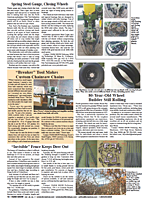You have reached your limit of 3 free stories. A story preview is shown instead.
To view more stories
(If your subscription is current,
click here to Login or Register.)
Ancient Breed Chickens Worth Considering
Lakenvelder chickens, an ancient breed from Germany, can add contrast to any backyard flock. These chickens are on the smaller side and boast an eye-catching pattern of black and white feathers. That’s clear from their Dutch name, which loosely translates to “white sheet over a black field.” You’ll see black hackles an
..........
You must sign in, subscribe or renew to see the page.

You must sign in, subscribe or renew to see the flip-book
Ancient Breed Chickens Worth Considering
Lakenvelder chickens, an ancient breed from Germany, can add contrast to any backyard flock. These chickens are on the smaller side and boast an eye-catching pattern of black and white feathers. That’s clear from their Dutch name, which loosely translates to “white sheet over a black field.” You’ll see black hackles and tail feathers contrasted with white feathers along the middle and black-tipped feathers at the wings. A Dutch breed of cattle goes by the same name, linked by location and their similar black and white patterning.
It’s thought that Lakenvelders are descendants of the Tel Megiddo chickens brought into Europe by Jewish immigrants around 1 AD. The breed was common by the 1700s, as the Dutch painter Van Gink mentions them as found in the southeastern corner of Holland. By 1835, the breed made an appearance in West Hanover poultry shows. Still, it took until the 1900s for Lakenvelders to arrive in the U.S., and they weren’t admitted to the American Poultry Association’s Standard of Perfection until 1939.
An active breed, Lakenvelders aren’t overly friendly. They pose a flight risk and occasionally show dominance over gentler chickens. Still, their vigorous foraging tendencies make them an excellent fit for small farms and homesteads. While known for tasty meat, the birds tend to be on the small side. They have round, plump breasts and medium-length shanks with short thighs. The hens are good egg-layers who don’t tend to go broody. Expect to get about 150 to 200 white or tinted eggs a year.
Like many heritage chickens, Lakenvelders have reached “threatened” status due to growing interest in hybrid breeds at the expense of heritage. Consider adding a few to your flock to keep their populations as vigorous as their foraging habits.
One source for Lakenvelders is the Chicken Coop Company (ph 888-222-5213; www.chickencoopcompany.com).
To read the rest of this story, download this issue below or click
here to register with your account number.





